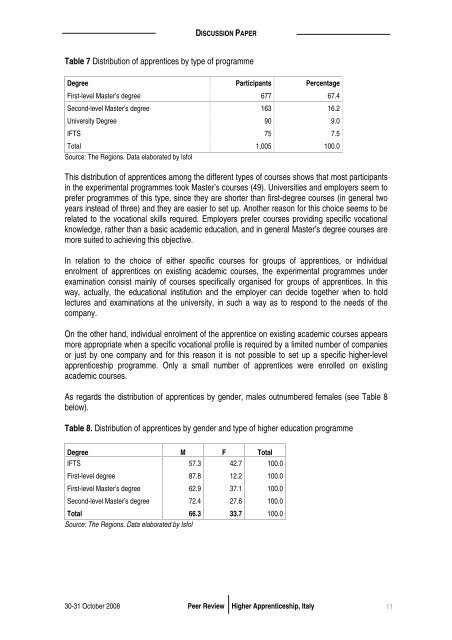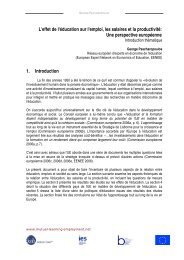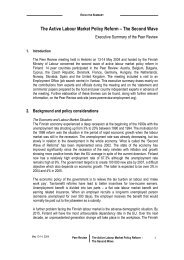Discussion Paper - Mutual Learning Programme
Discussion Paper - Mutual Learning Programme
Discussion Paper - Mutual Learning Programme
You also want an ePaper? Increase the reach of your titles
YUMPU automatically turns print PDFs into web optimized ePapers that Google loves.
DISCUSSION PAPER<br />
Table 7 Distribution of apprentices by type of programme<br />
Degree Participants Percentage<br />
First-level Master’s degree 677 67.4<br />
Second-level Master’s degree 163 16.2<br />
University Degree 90 9.0<br />
IFTS 75 7.5<br />
Total 1,005 100.0<br />
Source: The Regions. Data elaborated by Isfol<br />
This distribution of apprentices among the different types of courses shows that most participants<br />
in the experimental programmes took Master’s courses (49). Universities and employers seem to<br />
prefer programmes of this type, since they are shorter than first-degree courses (in general two<br />
years instead of three) and they are easier to set up. Another reason for this choice seems to be<br />
related to the vocational skills required. Employers prefer courses providing specific vocational<br />
knowledge, rather than a basic academic education, and in general Master’s degree courses are<br />
more suited to achieving this objective.<br />
In relation to the choice of either specific courses for groups of apprentices, or individual<br />
enrolment of apprentices on existing academic courses, the experimental programmes under<br />
examination consist mainly of courses specifically organised for groups of apprentices. In this<br />
way, actually, the educational institution and the employer can decide together when to hold<br />
lectures and examinations at the university, in such a way as to respond to the needs of the<br />
company.<br />
On the other hand, individual enrolment of the apprentice on existing academic courses appears<br />
more appropriate when a specific vocational profile is required by a limited number of companies<br />
or just by one company and for this reason it is not possible to set up a specific higher-level<br />
apprenticeship programme. Only a small number of apprentices were enrolled on existing<br />
academic courses.<br />
As regards the distribution of apprentices by gender, males outnumbered females (see Table 8<br />
below).<br />
Table 8. Distribution of apprentices by gender and type of higher education programme<br />
Degree M F Total<br />
IFTS 57.3 42.7 100.0<br />
First-level degree 87.8 12.2 100.0<br />
First-level Master’s degree 62.9 37.1 100.0<br />
Second-level Master’s degree 72.4 27.6 100.0<br />
Total 66.3 33.7 100.0<br />
Source: The Regions. Data elaborated by Isfol<br />
30-31 October 2008 Peer Review Higher Apprenticeship, Italy<br />
11





